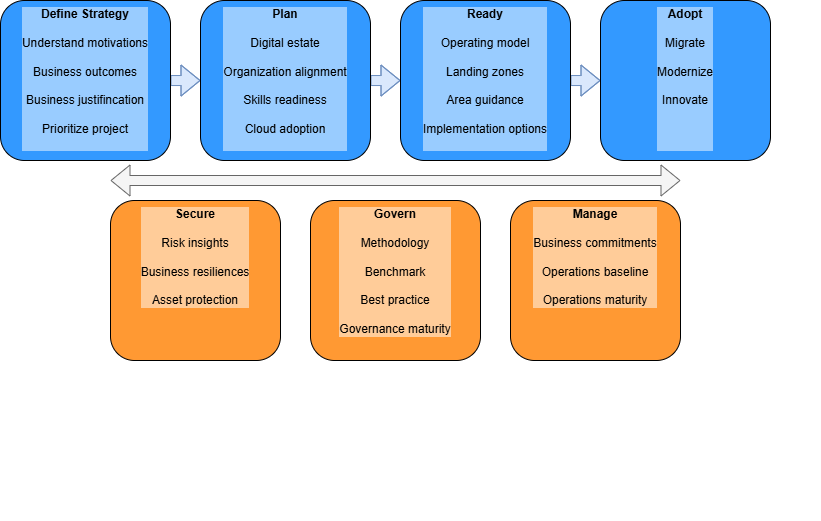Azure Cloud Adoption Framework
The Azure Cloud Adoption Framework, a comprehensive guide to help organizations plan, implement, and optimize their cloud adoption journey.
3 minute read
Technical Overview
The Azure Cloud Adoption Framework is a set of proven guidance, best practices, and tools designed to help organizations successfully adopt the cloud. It provides a structured approach to align business and technical strategies, ensuring a smooth transition to Azure while achieving desired business outcomes.
Key Methodologies:
Define Strategy
- Objective: Define business justification and expected outcomes.
- Key Actions:
- Identify business motivations for cloud adoption (e.g., cost savings, agility, scalability).
- Establish measurable goals (e.g., ROI, reduced downtime).
- Build a business case and secure stakeholder buy-in.
Plan
- Objective: Align actionable adoption plans to business outcomes.
- Key Actions:
- Assess the current IT landscape (applications, infrastructure, and data).
- Identify skill gaps and training needs.
- Define migration priorities and success criteria.
Ready
- Objective: Prepare your cloud environment for planned changes.
- Key Actions:
- Design and implement an Azure Landing Zone.
- Define governance and compliance policies.
- Establish identity, security, and networking baselines.
Adopt
- Objective: Migrate and modernize existing workloads.
- Key Paths:
- Migrate: Lift-and-shift workloads to Azure with minimal modifications.
- Innovate: Modernize applications using cloud-native technologies (e.g., Azure Kubernetes Service, Azure Functions).
Secure
- Objective: Improve security over time.
- Key Actions:
- Security posture modernization.
- Incident preparation and response.
- Confidentiality, Integrity, Availability (CIA)
- Confidentiality ensures that only authorized individuals can access sensitive information. This policy includes measures like encryption and access controls to protect data from unauthorized access.
- Integrity maintains the accuracy and completeness of data. This principle means protecting data from alterations or tampering by unauthorized users, which ensures that the information remains reliable.
- Availability ensures that information and resources are accessible to authorized users when needed. This task includes maintaining systems and networks to prevent downtime and ensure continuous access to data.
Govern
- Objective: Maintain control over cloud environments while enabling agility.
- Key Actions:
- Implement governance frameworks using Azure Policy and Azure Blueprints.
- Monitor compliance with business and regulatory standards.
- Define and enforce cost management strategies.
Manage
- Objective: Optimize operations and ensure continuous improvement.
- Key Actions:
- Implement monitoring and alerting using Azure Monitor.
- Automate repetitive tasks with Azure Automation.
- Perform regular reviews to improve performance and cost-efficiency.

Real-World Use Case
Scenario: A retail company wants to migrate its e-commerce platform to Azure to improve scalability and reduce operational costs.
Implementation:
- Strategy: Define business goals, such as reducing downtime during peak shopping seasons and optimizing costs.
- Plan: Assess the current infrastructure and create a migration roadmap using Azure Migrate.
- Ready: Set up Azure landing zones to ensure a secure and scalable environment.
- Adopt: Use Azure Site Recovery to migrate the e-commerce platform with minimal disruption.
- Innovate: Implement Azure Functions for serverless processing of customer orders.
- Secure: Use Azure Security Center to monitor and protect resources.
- Manage: Monitor application performance using Azure Monitor and Application Insights.
- Govern: Apply governance policies to ensure compliance with industry standards.
Benefits
- Structured Approach: Provides a clear roadmap for cloud adoption.
- Scalability: Ensures workloads are optimized for Azure’s scalability.
- Cost Optimization: Helps organizations control and reduce cloud expenses.
- Security: Implements robust security measures to protect resources.
- Operational Excellence: Enhances monitoring and management capabilities.
Resources
- Azure Cloud Adoption Framework Documentation
- Azure Migrate Documentation
- Azure Well-Architected Framework
Feedback
Was this page helpful?
Glad to hear it!
Sorry to hear that.